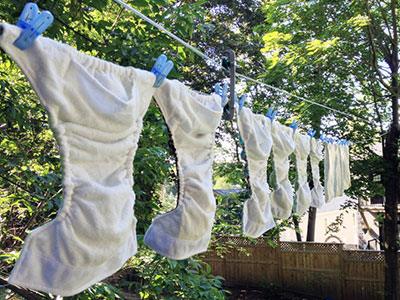 Bumpology shares the final word from environmental experts. (Hint: You will like the answer.)
Bumpology shares the final word from environmental experts. (Hint: You will like the answer.)
Many eco-conscious parents shared a sigh of relief when in 2005 the UK's Environment Agency announced that disposable diapers were no worse for the environment than reusable ones. Disposable diapers account for around 2.4 percent of the household waste that ends up as landfill in the UK, and few parents like the thought of bags of dirty diapers clogging up the countryside for hundreds of years (even if they are buried underground). Their degradation also produces methane, a potent greenhouse gas. However, laundering reusable diapers also takes an environmental toll, as energy is needed to fuel the washing machines that get them clean.
The Environment Agency concluded that neither type of diaper could claim environmental superiority. To put it in context, over the average two and a half years that a baby is in diapers, both are roughly comparable with driving a car between 1,300 and 2,200 miles in terms of greenhouse-gas emissions and depletion of nonrenewable resources.
The U.S.-based Union of Concerned Scientists has similarly advised parents not to waste a great deal of time or energy trying to weigh the environmental impact of the different types of diapers, because the differences aren't particularly dramatic. In its recently published Consumers' Guide to Effective Environmental Choices, the union suggests opting for cloth diapers if you live somewhere with shortages in landfill space, and disposable diapers if you live somewhere plagued by water shortages.
There are some circumstances in which cloth diapers can be greener. In 2008, the Environment Agency released an updated report concluding that the eco-credentials of reusable diapers varied widely according to how they were washed. Disposable and reusable diapers might produce similar greenhouse-gas emissions based on average washer and tumble-dryer use, but washing reusable diapers in fuller loads or line-drying the diapers outdoors reduced emissions by 16 percent, making them less damaging than disposables. If you did this and used the diapers for a second child, this would cut the environmental impact by 40 percent (although this is still only equivalent to driving some 620 miles by car). In contrast, if parents tumble-dried all their reusable diapers, this would increase their environmental impact by 43 percent, while washing diapers at 90°C (194°F) instead of at 60°C (140°F) would increase it by 31 percent.
In other words, you can cut the environmental impact of diapers by using reusable ones—so long as you're prepared to wait until you have a full load of wash, wash them at 120 to 140°F in an energy-efficient machine, and leave them to dry naturally.









